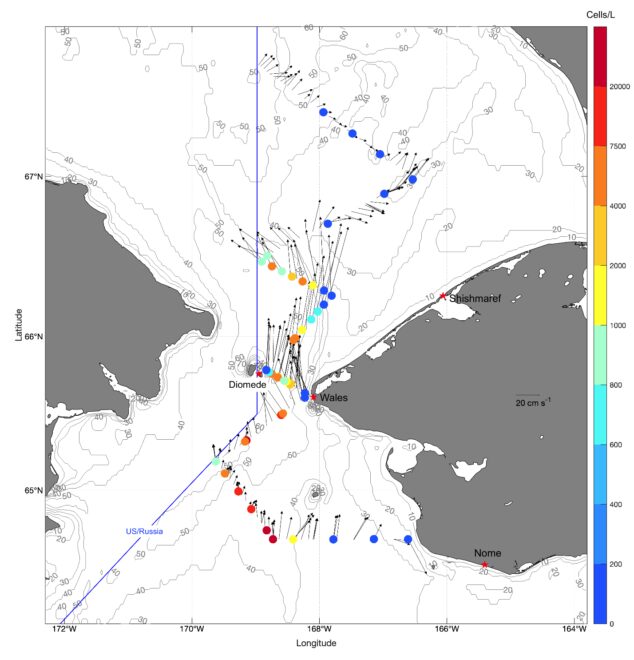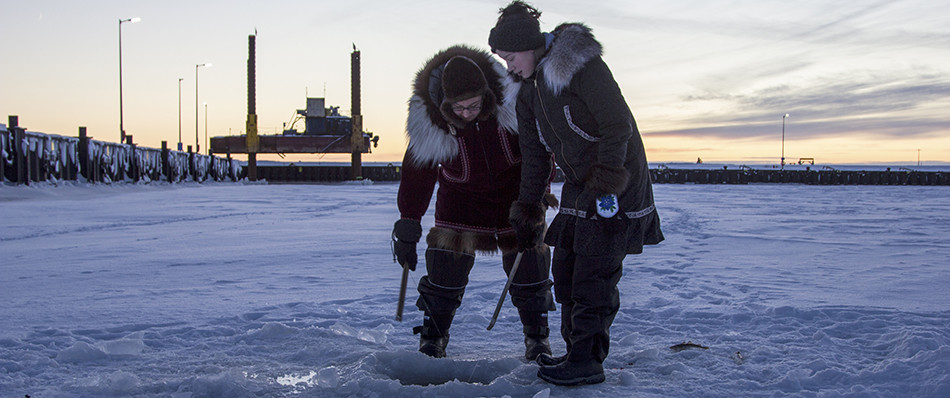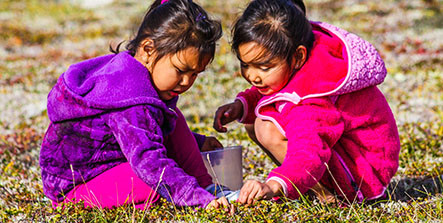PUBLIC SERVICE ANNOUNCEMENT (PSA)
HARMFUL ALGAL BLOOM (HAB) ADVISORY
High cell counts of the harmful algae species Alexandrium catenella continue to be detected in the Bering Strait region by equipment onboard the research vessel SIKULIAQ (see below).
• LOCATIONS OF CONCERN / CELL COUNTS:
o 29-July: approximately 75 nautical miles NNE of Savoonga (47,000 cells per liter of seawater)
o 28-July: 13 nautical miles southwest of Wales (6,000 cells per liter of seawater)
o 28-July: 4 nautical miles east of Diomede (7,000 cells per liter of seawater)
o See Figure 1 for a map of the locations.
• PSA HAB ADVISORIES for this event have been distribute since 28-July-2023
Monitoring efforts aboard the UAF-operated research vessel SIKULIAQ identified high concentrations of harmful algae called Alexandrium catenella in the Bering Strait. As the ship traveled east towards Nome, fewer Alexandrium catenella cells were detected. The algal species Alexandrium species is known to produce a suite of biotoxins called saxitoxins that can cause Paralytic Shellfish Poisoning. The cell concentrations of Alexandrium algae detected for various locations between July 28 – 29, 2023 are identified in the map below.
A concentration of 1,000 cells of Alexandrium catenella per liter of seawater is considered dangerous and high enough to trigger a public advisory for nearby coastal communities to be cautious when consuming marine wildlife resources, such as: clams, crabs, tunicates, etc. as well as the organs of marine mammals and seabirds.
Marine wildlife that consumed the Alexandrium algae directly or that obtained the toxin through eating prey that recently ate Alexandrium algae (ex. Walrus eating an affected clam) may contain a high concentration of saxitoxin that could affect animal and human health. Marine wildlife can accumulate toxins by feeding on zooplankton/krill, filter-feeding fish, tunicates, and other algae-eating animals within their food web. Current health risks are unknown to seabirds, marine mammals, or to humans who consume those resources. Be cautious and remain vigilant to changes in wildlife health and behavior.
Next steps:
● These are preliminary estimated Alexandrium densities pending laboratory analyses to confirm the species identity and toxicity.
● Individuals concerned about their subsistence-harvested seafoods are welcome to contact either Gay Sheffield at (907) 434-1149 or Emma Pate at (907) 434-0227 to coordinate shipping and lab testing for any saxitoxin levels in their seafoods.
● You cannot see, smell, or taste harmful algae toxins. Cleaning, cooking, or freezing affected foods will not lessen the toxin’s effects.
● The SIKULIAQ will not be sampling for Alexandrium catenella from July 30, 2023, to August 6, 2023, as they will be in Nome for scheduled dockside operations.
● If you feel sick eating any seafoods, please contact your healthcare provider immediately.
● For more information on harmful algae toxins in humans —symptoms, treatment, etc.—call the Alaska Section of Epidemiology: (907) 269-8000 Mon-Fri or (800) 478-0084 after hours.
If you see any marine wildlife acting in an unusual manner or dead, please contact:
BERING STRAIT REGION
● Norton Sound Health Corporation OEH Dept. (Nome) – Emma Pate (907) 434-0227
● Alaska Sea Grant (Nome) – Gay Sheffield: (907) 434-1149
● Kawerak (Nome) – Charles “Chuck” Menadelook: (907) 443-4265
NW ARCTIC BOROUGH
● Maniilaq – Office of Environmental Health (Kotzebue) – Chris Dankmeyer: (907) 442-7341
● Native Village of Kotzebue – Environmental Coordinator (Kotzebue) – Alex Whiting: (907) 442-5303
NORTH SLOPE BOROUGH
● NSB-Dept. of Wildlife Management (Utqiaġvik): (907) 852-0350
STATEWIDE
● NOAA Alaska Marine Mammal Stranding Network (Juneau): (877) 925-7773
● USFWS – Marine Mammals Management (Anchorage): (800) 362-5148



